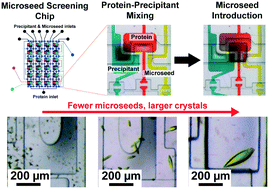X-ray transparent microfluidic platforms for membrane protein crystallization with microseeds†
Abstract
Crystallization of membrane proteins is a critical step for uncovering atomic resolution 3-D structures and elucidating structure–function relationships. Microseeding, the process of transferring sub-microscopic crystal nuclei from initial screens into new crystallization experiments, is an effective, yet underutilized approach to grow crystals suitable for X-ray crystallography. Here, we report simplified methods for crystallization of membrane proteins that utilize microseeding in X-ray transparent microfluidic chips. First, a microfluidic method for introduction of microseed dilutions into metastable crystallization experiments is demonstrated for photoactive yellow protein and cytochrome bo3 oxidase. As microseed concentration decreased, the number of crystals decreased while the average size increased. Second, we demonstrate a microfluidic chip for microseed screening, where many crystallization conditions were formulated on-chip prior to mixing with microseeds. Crystallization composition, crystal size, and diffraction data were collected and mapped on phase diagrams, which revealed that crystals of similar diffraction quality and size typically grow in distinct regions of the phase diagram.



 Please wait while we load your content...
Please wait while we load your content...